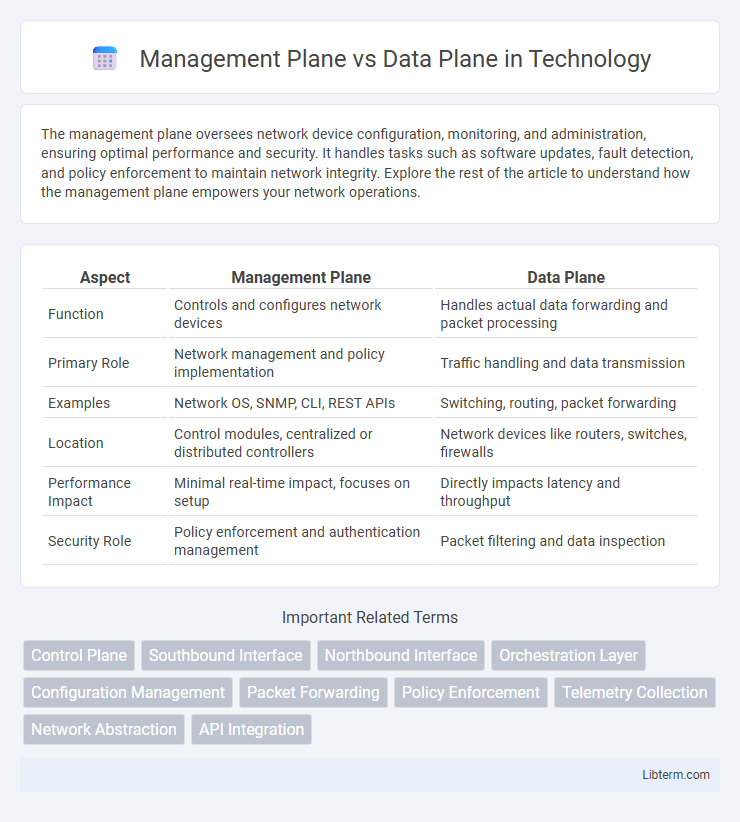The management plane oversees network device configuration, monitoring, and administration, ensuring optimal performance and security. It handles tasks such as software updates, fault detection, and policy enforcement to maintain network integrity. Explore the rest of the article to understand how the management plane empowers your network operations.
Table of Comparison
| Aspect | Management Plane | Data Plane |
|---|---|---|
| Function | Controls and configures network devices | Handles actual data forwarding and packet processing |
| Primary Role | Network management and policy implementation | Traffic handling and data transmission |
| Examples | Network OS, SNMP, CLI, REST APIs | Switching, routing, packet forwarding |
| Location | Control modules, centralized or distributed controllers | Network devices like routers, switches, firewalls |
| Performance Impact | Minimal real-time impact, focuses on setup | Directly impacts latency and throughput |
| Security Role | Policy enforcement and authentication management | Packet filtering and data inspection |
Introduction to Network Planes
The management plane supervises network devices by handling configuration, monitoring, and control protocols to ensure efficient network operations. The data plane, also known as the forwarding plane, processes and forwards data packets between interfaces based on routing and switching decisions. Together, these planes enable streamlined network functionality by separating administrative tasks from packet forwarding processes.
Defining Management Plane
The management plane controls and monitors network devices, handling configuration, policy implementation, and network administration tasks. It processes commands from network administrators and centralized controllers to maintain system performance and security. Unlike the data plane, which forwards user traffic, the management plane ensures operational oversight and efficient resource allocation.
Understanding Data Plane
The data plane handles the actual forwarding of user data packets through network devices based on routing and switching decisions. It operates at high speeds to process and forward traffic, ensuring efficient data delivery within the network infrastructure. The control plane, in contrast, manages routing protocols and determines the paths that data takes, but the data plane is responsible for executing those forwarding rules in real time.
Key Functions of Management Plane
The Management Plane is responsible for network configuration, monitoring, and overall control, enabling administrators to define policies and manage resources effectively. Key functions include device provisioning, performance monitoring, fault detection, and security management to ensure network reliability and compliance. This plane interacts with the Data Plane by sending control commands that dictate how data packets are processed and forwarded.
Core Responsibilities of Data Plane
The data plane is primarily responsible for the actual forwarding of packets based on predefined rules or policies, ensuring efficient and fast processing of data traffic within network devices. It handles packet switching, routing decisions at line rate, and applies filtering or quality of service (QoS) mechanisms directly on the data path. This separation allows the data plane to maintain high throughput while offloading control and management tasks to the management plane.
Differences Between Management Plane and Data Plane
The Management Plane controls and configures network devices, handling tasks such as device administration, policy enforcement, and network monitoring. The Data Plane, also known as the forwarding plane, is responsible for processing and forwarding packets based on the routing decisions made by the control plane. Unlike the Management Plane, which operates at a higher level with administrative access to network functions, the Data Plane operates in real-time to handle traffic flow efficiently without managing device configurations.
Security Considerations for Both Planes
The Management Plane controls network device configuration and monitoring, making it a prime target for attackers seeking unauthorized access or disruption; encrypting management traffic with protocols like SSH and implementing strong authentication mechanisms are critical security measures. The Data Plane handles the actual forwarding of user data packets, requiring robust protections against threats such as packet manipulation, spoofing, or denial-of-service attacks through techniques like access control lists (ACLs) and traffic filtering. Securing both planes involves segmenting management interfaces from regular network traffic and ensuring continuous monitoring for anomalous activities to maintain overall network integrity and confidentiality.
Real-World Use Cases and Applications
Management Plane oversees network policies, configurations, and monitoring, ensuring centralized control in enterprise networks, cloud infrastructure, and SDN environments. Data Plane handles packet forwarding and traffic processing at high speeds, critical for routers, switches, and firewalls in real-time applications like VoIP and video streaming. Combining both planes enhances network scalability, security, and performance across telecommunications, data centers, and IoT deployments.
Challenges in Managing Both Planes
Managing both the Management Plane and Data Plane involves challenges such as ensuring consistent policy enforcement across distributed network devices while minimizing latency in data forwarding. The Management Plane requires robust security measures to protect configuration and control traffic from attacks, whereas the Data Plane demands high-speed processing and scalability to handle massive volumes of user data efficiently. Balancing resource allocation between these planes is critical to prevent bottlenecks and maintain overall network performance and reliability.
Future Trends in Network Plane Separation
Future trends in network plane separation emphasize increased automation and artificial intelligence integration within the management plane to enhance dynamic policy enforcement and network orchestration. The data plane will evolve with programmable hardware and software-defined networking (SDN) technologies to achieve higher throughput and low latency for real-time traffic processing. Advances in network slicing and intent-based networking will further decouple the management and data planes, enabling more flexible, scalable, and secure network architectures.
Management Plane Infographic

 libterm.com
libterm.com